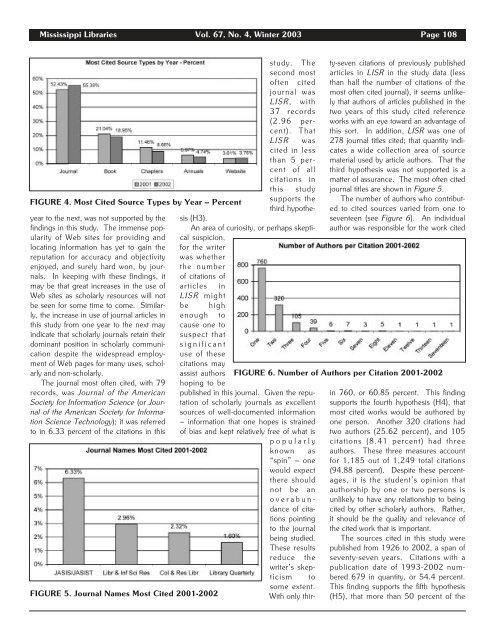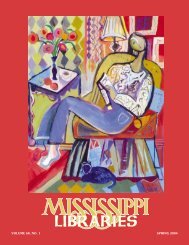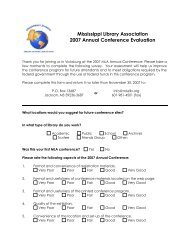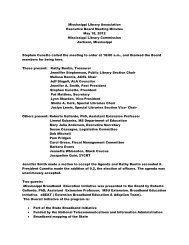Full Text (PDF) - Mississippi Library Association
Full Text (PDF) - Mississippi Library Association
Full Text (PDF) - Mississippi Library Association
You also want an ePaper? Increase the reach of your titles
YUMPU automatically turns print PDFs into web optimized ePapers that Google loves.
<strong>Mississippi</strong> Libraries Vol. 67, No. 4, Winter 2003 Page 108<br />
FIGURE 4. Most Cited Source Types by Year – Percent<br />
year to the next, was not supported by the<br />
findings in this study. The immense popularity<br />
of Web sites for providing and<br />
locating information has yet to gain the<br />
reputation for accuracy and objectivity<br />
enjoyed, and surely hard won, by journals.<br />
In keeping with these findings, it<br />
may be that great increases in the use of<br />
Web sites as scholarly resources will not<br />
be seen for some time to come. Similarly,<br />
the increase in use of journal articles in<br />
this study from one year to the next may<br />
indicate that scholarly journals retain their<br />
dominant position in scholarly communication<br />
despite the widespread employment<br />
of Web pages for many uses, scholarly<br />
and non-scholarly.<br />
The journal most often cited, with 79<br />
records, was Journal of the American<br />
Society for Information Science (or Journal<br />
of the American Society for Information<br />
Science Technology); it was referred<br />
to in 6.33 percent of the citations in this<br />
FIGURE 5. Journal Names Most Cited 2001-2002<br />
study. The<br />
second most<br />
often cited<br />
journal was<br />
LISR, with<br />
37 records<br />
(2.96 percent).<br />
That<br />
LISR was<br />
cited in less<br />
than 5 percent<br />
of all<br />
citations in<br />
this study<br />
supports the<br />
third hypothesis<br />
(H3).<br />
An area of curiosity, or perhaps skeptical<br />
suspicion,<br />
for the writer<br />
was whether<br />
the number<br />
of citations of<br />
articles in<br />
LISR might<br />
be high<br />
enough to<br />
cause one to<br />
suspect that<br />
significant<br />
use of these<br />
citations may<br />
assist authors<br />
hoping to be<br />
published in this journal. Given the reputation<br />
of scholarly journals as excellent<br />
sources of well-documented information<br />
– information that one hopes is strained<br />
of bias and kept relatively free of what is<br />
popularly<br />
known as<br />
“spin” – one<br />
would expect<br />
there should<br />
not be an<br />
overabundance<br />
of citations<br />
pointing<br />
to the journal<br />
being studied.<br />
These results<br />
reduce the<br />
writer’s skepticism<br />
to<br />
some extent.<br />
With only thirty-seven<br />
citations of previously published<br />
articles in LISR in the study data (less<br />
than half the number of citations of the<br />
most often cited journal), it seems unlikely<br />
that authors of articles published in the<br />
two years of this study cited reference<br />
works with an eye toward an advantage of<br />
this sort. In addition, LISR was one of<br />
278 journal titles cited; that quantity indicates<br />
a wide collection area of source<br />
material used by article authors. That the<br />
third hypothesis was not supported is a<br />
matter of assurance. The most often cited<br />
journal titles are shown in Figure 5.<br />
The number of authors who contributed<br />
to cited sources varied from one to<br />
seventeen (see Figure 6). An individual<br />
author was responsible for the work cited<br />
FIGURE 6. Number of Authors per Citation 2001-2002<br />
in 760, or 60.85 percent. This finding<br />
supports the fourth hypothesis (H4), that<br />
most cited works would be authored by<br />
one person. Another 320 citations had<br />
two authors (25.62 percent), and 105<br />
citations (8.41 percent) had three<br />
authors. These three measures account<br />
for 1,185 out of 1,249 total citations<br />
(94.88 percent). Despite these percentages,<br />
it is the student’s opinion that<br />
authorship by one or two persons is<br />
unlikely to have any relationship to being<br />
cited by other scholarly authors. Rather,<br />
it should be the quality and relevance of<br />
the cited work that is important.<br />
The sources cited in this study were<br />
published from 1926 to 2002, a span of<br />
seventy-seven years. Citations with a<br />
publication date of 1993-2002 numbered<br />
679 in quantity, or 54.4 percent.<br />
This finding supports the fifth hypothesis<br />
(H5), that more than 50 percent of the














